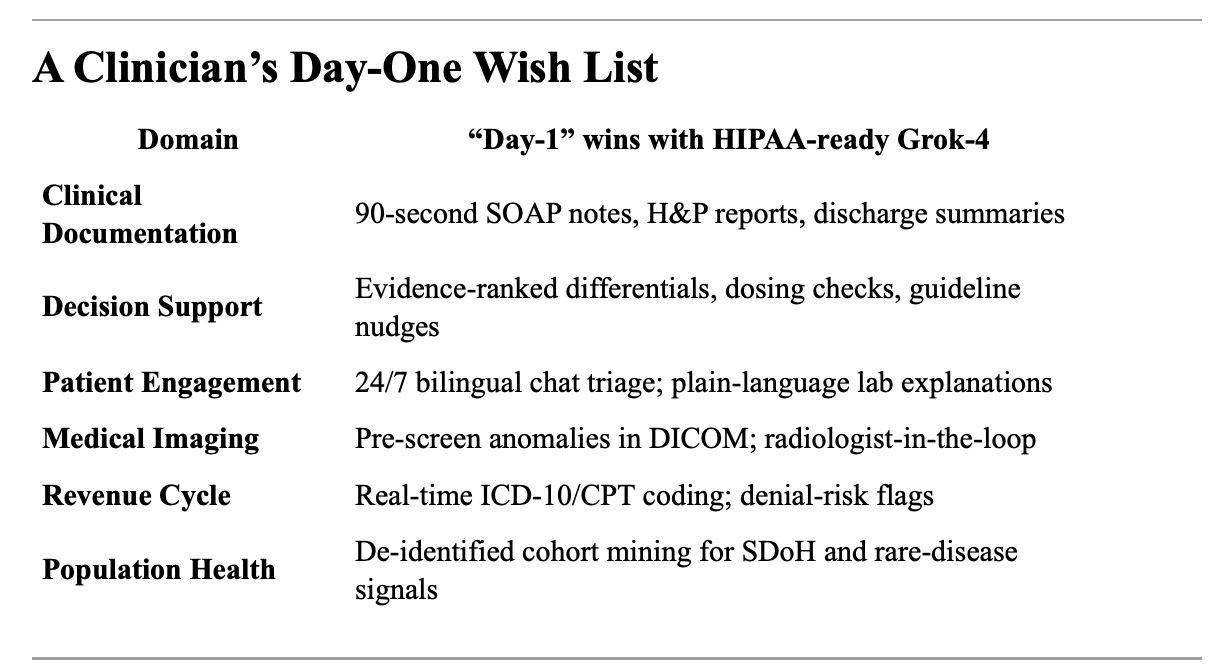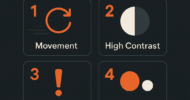When ChatGPT burst onto the scene in late 2022, many clinicians glimpsed the future then ran smack into a wall of red tape labeled “HIPAA.” Since then, large-language models (LLMs) have matured from clever chatbots into workhorse tools that summarize admission notes, draft prior-authorization letters, and even suggest antibiotic dosing. Yet most models still sit outside the guarded perimeter of protected health information.
Grok 4, the next-generation model from xAI, could finally bring useful clinical AI inside that boundary. Scheduled for release in 2025 and rumored to break the trillion-parameter mark, Grok 4 is being trained on roughly 300,000 NVIDIA-class GPUs. That scale matters: More parameters and better-curated data unlock a wider clinical vocabulary, deeper reasoning paths, and critically native multimodal skills. In practice, Grok 4 should read an MRI slice, glance at the radiologist’s note, and relate both to the patient’s current medication list all in a single session.
A clinician’s day-one wish list

The HIPAA elephant in the exam room
None of this happens until Grok 4 can swim in PHI without springing leaks. xAI has signaled its intent to offer a HIPAA-eligible environment, but the heavy lift falls on hospitals and practices.
- Business Associate Agreement (BAA). Without it, nothing moves.
- “Minimum necessary” data maps. A model doesn’t need the entire chart to draft a discharge summary—just the diagnosis, key labs, and follow-up plan.
- Technical safeguards. Role-based access, end-to-end encryption, immutable audit logs, and automatic redaction of stray identifiers now belong on the must-have list.
A five-step playbook for early adopters
- Sandbox first (30 days). Feed de-identified notes; measure hallucination rate, citation accuracy, latency.
- Layer security. Enforce RBAC, log immutably, and redact on ingress.
- Validate clinically. Double-read AI output; track override reasons—these become your quality dashboard.
- Roll out progressively. Start with low-risk, text-heavy documents (after-visit summaries) before graduating to medication dosing or diagnostic suggestions.
- Monitor continuously. Language drifts, guidelines evolve, models age. Quarterly HIPAA audits and real-time drift detection keep today’s safe output from becoming tomorrow’s liability.
Why act now?
First movers shape Grok 4’s specialty-tuned checkpoints. Oncology teams that feed anonymized chemo protocols into the sandbox will mature the hematology-oncology version sooner and help the next patient faster. Waiting for a generic, one-size-fits-all release means bending the tool to your workflow later.
The bottom line
AI will not replace clinicians, but clinicians who master HIPAA-compliant AI will replace those who don’t. Grok 4 promises the horsepower to draft notes, interpret images, and surface evidence all while keeping patient data inside the regulatory fence. The technology is coming either way; the only question is whether we shape it or let it shape us.
Harvey Castro is a physician, health care consultant, and serial entrepreneur with extensive experience in the health care industry. He can be reached on his website, harveycastromd.info, Twitter @HarveycastroMD, Facebook, Instagram, and YouTube. He is the author of Bing Copilot and Other LLM: Revolutionizing Healthcare With AI, Solving Infamous Cases with Artificial Intelligence, The AI-Driven Entrepreneur: Unlocking Entrepreneurial Success with Artificial Intelligence Strategies and Insights, ChatGPT and Healthcare: The Key To The New Future of Medicine, ChatGPT and Healthcare: Unlocking The Potential Of Patient Empowerment, Revolutionize Your Health and Fitness with ChatGPT’s Modern Weight Loss Hacks, Success Reinvention, and Apple Vision Healthcare Pioneers: A Community for Professionals & Patients.




















![Why mocking food allergies in movies is a life-threatening problem [PODCAST]](https://kevinmd.com/wp-content/uploads/Design-3-190x100.jpg)
![Why being your own financial planner is costing you millions [PODCAST]](https://kevinmd.com/wp-content/uploads/Design-1-190x100.jpg)
